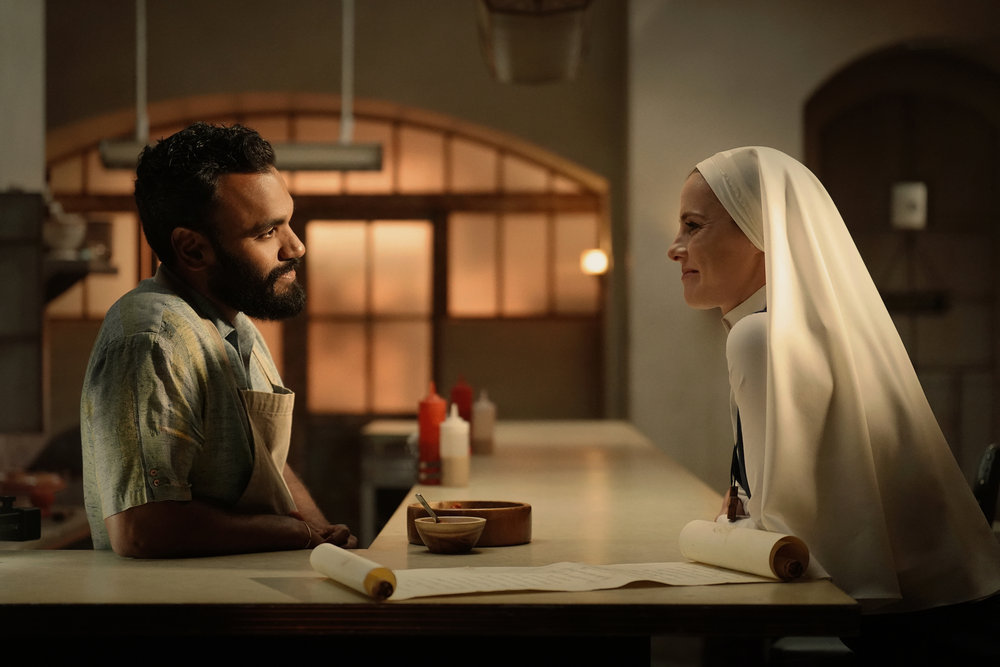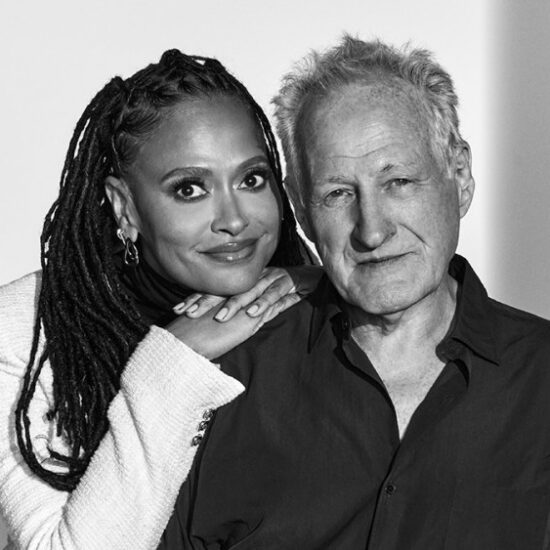
This interview for the Filmmaker Toolkit podcast took place in April 2023, before the beginning of the Writer’s Strike.
The sum total of “Mrs. Davis” and the genres and tones with which it plays couldn’t fill the belly of a whale, but it comes pretty damn close. It is, in brief, one nun’s (Betty Gilpin) quest to find the Holy Grail — yes, that Holy Grail — amid heists and conspiracies and Reno magicians because an all-powerful AI told her it would shut itself off if she succeeded. This isn’t even getting into the dilemma of Jesus — yes, that Jesus — who has a very special relationship with Sister Simone.
The balancing act of the Peacock series required a firm understanding of the many sandboxes in which “Mrs. Davis” was playing, tonally and visually. If there was a place between inane hijinks and profound questions about our relationship to our creators, “Mrs. Davis” wanted to find it.
But it’s often through the show’s most farcical setpieces that it sneaks in its most poignant character relationships and dilemmas. Case in point, the ultimate location of the Grail in the belly of a whale, which swallows Simone and also acts as a kind of spiritual cave where she meets a very important mother (Shohreh Aghdashloo) and re-evaluates all of her relationships.
“All the classifications or, you know, the loglines that get thrown at this show — it’s a quest, it’s the Holy Grail, it’s nun versus AI, it’s sort of this backdoor examination of female relationships and female dynamics — specifically, [the relationships between] mother and daughters became of very real interest to us,” series co-creator Tara Hernandez told IndieWire’s Filmmaker Toolkit podcast.
There’s so much wrapped up in the philosophical ideas that the show plays with (free will versus destiny, the power of technology and religion to warp society while creating tangible good at the individual level, the slow nervous breakdown some men need to take off their cowboy boots, metaphorically speaking) that Hernandez and co-creator Damon Lindelof sought a visual world that could be equally contradictory in an enjoyable way.
“Owen Harris was available [to direct the pilot] and both Damon and I were huge fans of ‘Black Mirror,’ where he had done two of my favorite episodes, ‘Striking Vipers’ and ‘San Junipero,’” Hernandez said. “The worlds he created within those episodes are sort of timeless — or very timely, as far as the ’80s aesthetic — but it feels five minutes in the future and totally decades away. I think we both thought, from an aesthetic standpoint, that is so incredibly interesting.”
Hernandez and Lindelof also encouraged Harris and the series’ other directors to embrace a myriad of visual influences as they developed a heightened idea of the American West in which Simone and her estranged childhood sweetheart Wiley (Jake McDorman) set out to destroy Mrs. Davis.

The show’s influences included “the overlapping Venn diagram of Quentin Tarantino’s writing and ‘Looney Tunes’ and ‘Monty Python’ [with] this sort of idea of zaniness and unpredictability,” Lindelof told IndieWire. (Editor’s note: That interview took place before the publication of excerpts from Maureen Ryan’s Burn It Down, which reports on, among other things, a toxic culture in the “Lost” writers room run by Lindelof and Carlton Cuse.)
“And if you’re looking solely in the Tarantino circle of that Venn diagram, there’s also a level of over-the-top violence. So we would often talk about the idea of, like, ‘There’s a way to do this sword fight in the opening of the show, which is ultimately going to be revealed to be a commercial, where you’re expected to take the violence seriously,’” Lindelof said. But the show must play the trick and do the work so that the reveal feels earned, which meant choreographing a certain kind of emphasis and absurdity into the “serious” version of the fight — something that felt just a little bit off, but that the audience can’t quite place.
“That can be a bit disquieting because you don’t know what the tone is. But for us, that is kind of the bandwidth on which life is transmitting. That’s, to me, the most exciting storytelling space, where you enter into the realm of the indescribable and you say you just have to watch it,” Lindelof said.
“I think from the jump we had been pushing the line, or actively jumping over it,” Hernandez said of the whale sequence in particular and the ethos of “Mrs. Davis” generally. The constant forward momentum of seeking new ways to connect wilder, seemingly ordained incidents with mundane, all-too-human motivations (to say nothing of the motivations of Buffalo Wild Wings) propels “Mrs. Davis.” But the fact that there is a connection, expressed in heightened visuals before the characters and the audience figure it out, makes the show’s surprises meaningful.
“The show was a kind of stealth, chosen one journey all along, but at the same time kind of trolling it. It’s a delicate balance. Not sure we got it right, but boy, was it fun up there on the wire,” Lindelof said.














